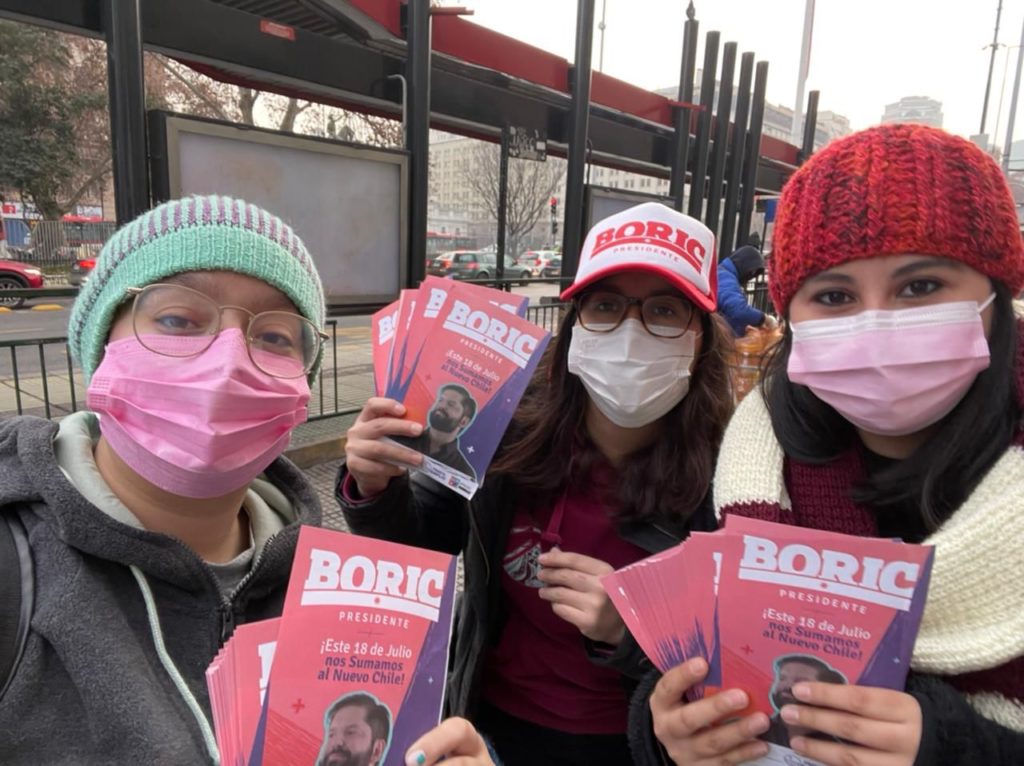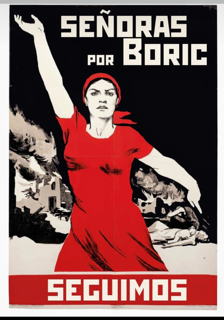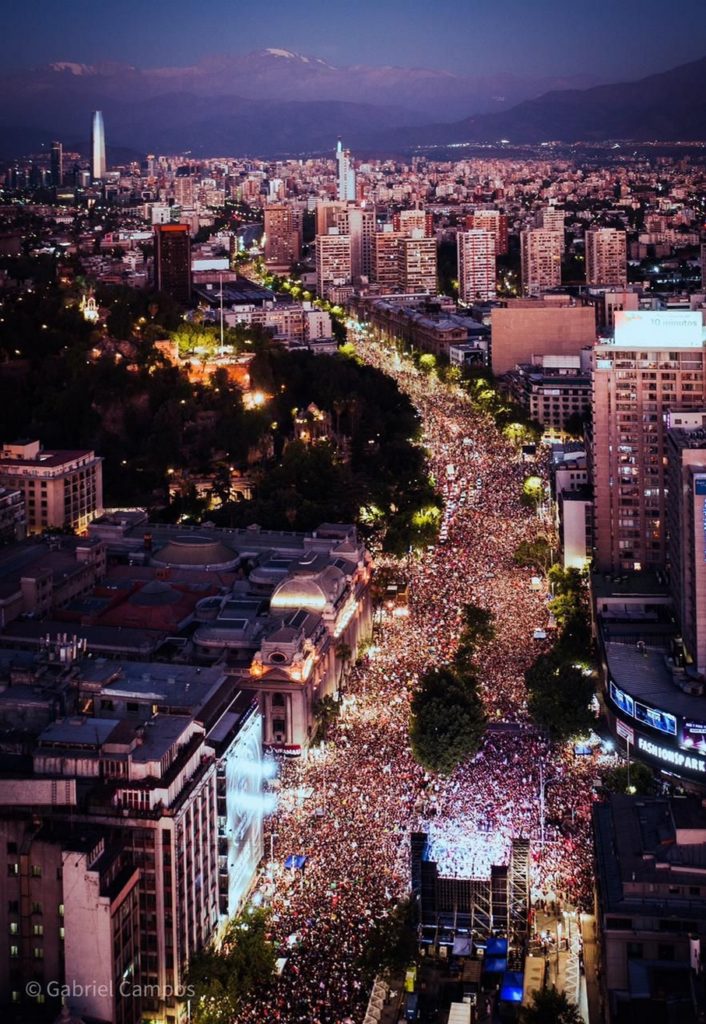by Lorena Núñez Carrasco and Jeremy Daphne, 25 January 2022
Incredible – as on the evening preceding the presidential election, a very real and terrifying prospect faced Chileans, and especially Chilean women. As stated by Rodrigo Saavedra, a Santiago lawyer and activist, it’s a ‘’scary mood, never before in the past thirty years we’ve been so near to having a fascist as an elected president. Still, I have a hope that this is only a bad nightmare and at the end we will wake up having made the right choice as a country.’’
This predicament was particularly pertinent for women, as a win by far-right Jose Antonio Kast, based on election promises, would have had a devastating impact.
The right choice!
And the country made the right choice! By the evening of that election day Kast had conceded defeat, with a convincing win for 35-year-old, ex-student leader Gabriel Boric, with 56% of the vote. In his victory speech he described himself as a person who “listens more than he talks” and vowed to fight “the privileges of the few”, along with radically overhauling Chilean society and its economy. This was a win for the Chilean new left movement and in particular, the feminist movement. It is no coincidence that the celebrating crowds were dominated by women and especially young women. It was also no coincidence that women spearheaded Boric’s campaign after losing to Kast in the first round of elections.

His victory is a vindication of the social uprising that erupted on Chilean streets in October 2019, driven by the new movement. This was a revolt of women, workers, the youth, the poor and the struggling middle class against decades of the Pinochet-induced neoliberal order, including its highly patriarchal nature. Much has already been written on the detail and meaning of Boric’s astounding victory. In this article we focus on what does the Boric win mean for women and especially working class women.
A new pathway for women
Perhaps never before has the future looked so bright and promising for the position of women in Chilean society and the economy! Not since the rise of the left movement in Chile in the 1930s and Salvador Allende’s ascendency to power in 1970. This we assert is the most significant aspect to Boric’s win. It also constitutes a litmus test for the Boric government that will gain power in March 2022.
What inspires this bold claim? The reasons are many, involving factors that positively impact either directly or indirectly on the future of women in Chile. In this article we concentrate on key factors at play. In so doing it is important to map out the role of Chile’s powerful feminist movement, including its role in the October uprising, the successful elections for the Constitutional Assembly and subsequent campaigning for Boric.
Womenpower secures Boric’s victory

Starting with most recent developments, after trailing Kast in the first round of elections, Boric and his Apruebo Dignidad coalition won the second round with the most votes ever in history of Chilean elections. Little has been said in the media about the role of young women in Boric winning against a confident Kast. It was in fact young women from left organisations who came to the fore, carrying out door to door organising across Chile and facilitating a definitive victory for Boric. Central to this was the decisive role of three young feminist women.
One of them is 33-year-old Camila Vallejo, member of the communist party and spokesperson for Boric’s campaign, whose alliance with Boric goes back to the 2011 students’ movement. The second is Carol Kariola, 34 and with a similar background. She took the responsibility to convince indecisive voters in the south of Chile. The third woman is Izkia Siches, 35 years old, politically independent and a medical doctor. She became one of the most credible voices during the Covid-19 pandemic. Still breastfeeding her 6-month-old baby, Siches travelled with her family and team throughout the north of the country, reversing the support Kast gained in the first round.
The campaigning carried out by the three women and many more young women on the ground was critical to mobilising the youth and women – and achieving the 1,2 million new voters that came out in the second round.

The current feminist movement has a long history, going back to opposing the Pinochet dictatorship. It was however over the last decade that the feminist movement grew rapidly, particularly amongst the youth. For example, the law against sexual harassment and sexual abuse in education was initiated and led by young feminists in May 2018, with massive mobilisation of thousands of students and women’s organisations.
The feminist movement played a dynamic role in the October 2019 uprising, inspiring women outside the movement to join in as well. For example, through the ‘Las Tesis’ feminist street guerrilla interventions that spread throughout Chile. Created by a group of four young women activist artists and replicated by thousands of women in the country and beyond, women of all ages gathered in public spaces chanting a powerful critique against patriarchy and the elite.
As a key outcome of the uprising, it was the feminist movement that ensured gender parity in the 155-seat Constitutional Convention that Chileans overwhelmingly voted for. Women also took the lead in gaining public positions in the May 2021 elections for governors, mayors and councillors that accompanied the elections for Constitutional Convention seats. For example, the mayor of central Santiago is now a young woman from the Communist Party.
Feminism is now affecting the institutional order and has permeated everyday practices and politics in all sectors. This for example is reflected in the formal use of a more inclusive language and the rejection of the use of the masculine gender.
Every reason to be optimistic looking forward
Following this backdrop description, a central reason to be optimistic about the future of all women in Chile is the power, level of organisation and deeply embedded nature of the Chilean feminist movement, which includes a strong anti-neoliberalism stance. This movement stands to continue growing and having a significant impact in the process of forging a new Chile. Importantly and as a direct reflection of this, is the recent announcement of the new Boric cabinet, consisting of 14 women and 10 men, with women leading portfolios traditionally associated with male power, including the ministry of interior, foreign affairs, defence and justice.
Many of the women within Boric’s close circle are now in his cabinet. Dr Izkia Siches is Minister of Interior, a position for the first time in history held by a woman. This is the most senior ministerial position. Camila Vallejo is the government spokesperson, a position with ministerial ranking. A powerful symbolic nomination is that of Maya Fernandez Allende, granddaughter of Salvador Allende, as the Minister of Defence. She will be in charge of the forces that brutally overthrew Allende’s socialist government almost 50 years ago. Importantly, the Ministry of Women will include ensuring the integration of gender perspectives across all government functions and public policy.
A good example of the feminist movement in action is the recent public proposal for free abortion, which was presented to the Constitutional Convention, drafted by a network of feminist organisations. Critically, the equal number of women and men in the Constitutional Convention and the fact that it is dominated by left groupings directly representative of communities is another key reason to be optimistic, with the strong possibility of a feminist constitution emerging, along with its beneficial impacts.
At a more personal level, Irina Karmanos (32), Boric’s partner, is a feminist leader of the Convergencia Social, Boric’s party. As Boric’s partner, she made public that she is ready to rethink the traditional role of ‘first lady. Boric himself has publicly declared his commitment to the feminist cause. This also bodes well for the position of women going forwards.
Also on a positive note, Boric’s rise to power comes at an important and opportune moment in Latin American left political developments. This includes all three neighbouring countries to Chile having left leaning governments (Argentina, Bolivia and Peru). It is also likely that in Brazil and Columbia, amongst other countries, right wing governments will be defeated within the near future. This also bodes well for the Boric government and its ability to deliver on its mandate.
Don’t underestimate the new Chilean movement!
There is no doubt that the Boric government will face many layers of challenges, central to which is unravelling the deeply entrenched neoliberal system. The Chilean right in all its forms, while having lost considerable ground, are still a powerful presence. It is also clear that Boric will be under significant pressure to make compromises that could undermine the delivery of his mandate. Sceptics will point to the mistakes made by other left governments on gaining power.

However, there is something completely new happening in Chile, that must not be underestimated. This is the new movement – a new force, a new phenomenon, with a clear direction and vison! It shows significant potential to not repeat historical mistakes, to outmanoeuvre the right and continue its already ground-breaking march to a new world for all Chileans, and women in particular!
Important ingredients for success in this regard are a young and dynamic government with an emancipatory vision, a strong community-based movement that will apply pressure from ground level, the likely advent of a new feminist constitution, the rising Latin American left movement, and a highly mobilised society full of hope, energy and determination. Salvadore Allende’s 1970 dream of working class well-being has come alive yet again!
As concluded by novelist and activist Ariel Dorfman in reflecting on Boric’s victory (Jacobin, 23 December 2021), “I have seen what the men and women of Chile can do when they are called to a noble cause. I can only pray that now, yet again, my country will be a shining example of liberation for a turbulent world that is crying out for some light in the midst of so much darkness.”


